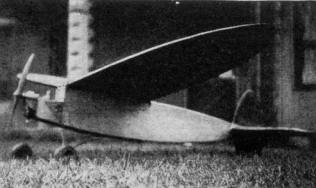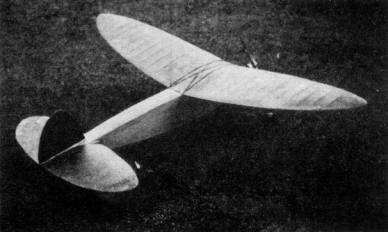|
The RISER RIDER Presenting another champion, trophy winner at the Mississippi Valley Contest -- a ship of ultra modern design that traveled 100 miles on its winning flight -- the 22nd Air Trails Trophy Winner.
By Roy Marquardt
THE day of the outdoor events of the Mississippi Valley Contest dawned clear and hot. Our own Burlington, Iowa, group had camped at the Parks Airport in East St. Louis in order to be first on the scene. But we weren't. It was hardly dawn before we heard winders turning and motors popping. After telling the world what we thought of people who disturbed such wonderful dreams of trophies and cross-country flights, we proceeded to add to the din in a more orthodox manner. An unusually large number of contestants kept the meet from getting under way until 11 a. m. Soon after, Riser Rider was ready for a flight with 3-1/2 sixteenths of an ounce of gas in the tank. A few seconds later she was high in the air. The motor cut at about 3 minutes, the nose seemed hardly to clip-it was already on a riser. Roads from the airport toward the Mississippi seemed to have a terrifying ability to end abruptly, but finally one went through, and 23 minutes after launching, we stood on the Mississippi levee and watched the model disappear over downtown St. Louis. Fortunately the model carried my name and address and two days later it was reported found 30 miles away, 9 miles on the other side of the city limits of St. Louis. Judging by wind velocity, the model was in the air at least 4 hours after we lost it and trust have traveled 100 miles in a straight line -- all on less than 1/4 ounce of gas -- representing a fuel consumption of 51,000 miles per gallon. Although very easy to build, the model incorporates several new features. The wing and tail are double elliptical, combining beauty and the most efficient outline known. A new method of construction makes it unnecessary to plot all the ribs individually. Fuselage is extra sturdy. An elliptical cross-section would have less drag, but ease of construction and the addition of lift and stability from the duck-shaped tail more than counteract this. Low speed, high thrust line, fuselage shape and the split rudder tend to produce a much more stable combination than the usual contest model. WING Plot a 16" Eiffel 431 from the co-ordinates on Plate 3. The ribs themselves are 1/16" smaller than this all around. Transfer to thin metal and cut out. Ribs are cut like ribs for indoor models -- from a 1/16 x 16 x 12" sheet made by gluing 2" widths together. Place template on wood and cut around the top edge only. Move template down 1/4" and repeat until the required number of strips have keen cut. Then turn the template over and repeat, using the bottom edge as the cutting edge. Cut from the rear to the proper length. Cut front and rear of the strips so that top and bottom join perfectly. Rear should be 1/8" high as it hits the trailing edge. Glue up ribs and make a 1/16" notch in the nose for the leading edge, 7/16 " deep. Draw a full-size pattern for the wing half. Draw a center line and plot the leading edge as shown by the outside dimensions. Then plot in spars and trailing edge. The spar patterns should be on a separate sheet. The spar heights given are sufficient to plot accurately, but if more accuracy is desired, the metal rib template may be placed over a line parallel to the rib line on the plans at the point desired so that the nose of template is centered on the line. Move the rear of the template so that top edge hits the line just at the trailing edge of the wing. Draw around it. Move the rib template up so that the bottom meets the line at the same point and draw around. This is full-wing size and spars should be 1/16" smaller than this at top and bottom. Cut spars from 1/8" hard balsa sheet. Cut 1/16 x 1/4" notches for the ribs. The trailing edge is formed from 1/4 x 1" strips. Place strip over the pattern parallel to the center line, and starting at the middle cut around the outside. Glue the piece just cut off on the inside at the same distance out. Repeat until the grain cuts across too sharply, then turn the strip until it is tangent to the curve and cut a new angle. (Notice grain lines on Plate 2). Carry this size wood around the tips. The leading edge is made in the same manner from 1/8 x 1/2" strips. Assemble entire wing and glue. Cover leading edge back to front spar with 1/16" sheet. If difficulty is experienced in bending at the extreme nose, 1/8 x 1/16" strips may be planked in around sharp bends. Put on 1/4 x 1/16" cap strips flush with top of trailing edge and leading edge covering. Cover center section and tips with 1/16" sheets. Tips should have a streamlined section. Sand carefully and give all joints an extra coat or two of thin glue. The original wing was covered with silk, but other material may be used. Apply two coats of clear and one coat of orange airplane dope thinned with 50% thinner. If silk is used, be careful to fill all pores in the silk. If the first coat does not do this, a little flour or wood filler may be mixed with the dope. It is best to sand with very fine sandpaper between coats. When finished the wing should be perfectly flat except for the extreme tips, which are more efficient with a slight negative angle. ELEVATOR The elevator is essentially the same as the wing. A 12" M16 airfoil is used with one spar. Cover the leading edge with 1/16" sheet, only 1-1/4" back. Put on center covering and cap strips as on the wing. Cover with silk. Apply only one coat of clear dope before using colored dope. FUSELAGE Draw full-size fuselage plans. Assemble two sides from 1/4" square hard balsa. Notch thrust-line longerons and front upright halfway so that they join flush. Assemble the fire wall, motor skid and brackets. The motor skid must be cut to different sizes for different motors. The model was flown at St. Louis with a Cyclone, but more recently a Brown was installed for 30-second motor run tests. Either motor -- or for that matter any motor in this size range -- will give excellent results. The larger motor has slightly the edge for limited motor run, if you know your model and can keep it flying in just the right circle. If you are in doubt as to the size of motor you are going to use, cut skid for largest motor. Later you can make a reduction plate of light steel with holes to fit both motors and a cut-out to fit the smaller. As most of the tanks furnished will not work efficiently with 1/4 ounce or less, make a small gas tank holding about 3/8 ounce of gas from sheet metal. If a Cyclone is used, the tank must be mounted on a block so that the bottom is about 3/8" above the motor skid. In the writer's opinion suction-feed motors (Brown, etc.) are more efficient than the gravity-feed kind. Mount tank on the skid and when motor is put in, connect the bottom of the tank to the motor with rubber tubing. Use 1/2" fine screws for attaching brackets to fire wall. No screws are needed to fasten bracket to skid as motor screws go through both. Cut cross-pieces and assemble body sides, putting in nose assembly last. Top cross-pieces at rear are not to stay in, but put them in first in order to line up the assembly. Put short pins in all joints and apply an extra coat of thin glue all around. Cover sides with 1/16" sheet gluing to all members. Trace M6 template on both sides of fuselage at rear, putting reference line of the airfoil right on the thrust line. Cut away covering and frame so that elevator can be slid into place. Glue firmly. Cover bottom of body with sheet balsa. Glue in 1 x 1/4 x 16" battery track. Put in wiring according to Plate 1. Solder all connections carefully. Switch plug-ins are mounted on a thin panel of hard wood. (Our plug-ins were taken from an old radio tube socket). Wires passing over motor skid are glued down. Cover condenser wires with glue. A Burgess battery was used on this model, but regulation battery box and flashlight batteries may be used. Sew and glue wing hooks on side of body. Cover the top of the body except where wing goes on. Sand smooth. Make rudder top and bottom using 1/4 x 1" balsa outline all around. Use solid 3/32" ribs of streamline shape and cover shaded portion with 1/16" sheet. Cover with silk and glue to the body. Set at zero degree angle. Fillet all tail connections with plastic balsa (balsa sawdust mixed with glue or thick dope). Mold with fingers. When dry, sand and cover with strips of silk. Cover whole body with silk. Bend landing gear from 1/8" steel wire. Bend a 23" strip so that it has a 4" center, 8" struts and 1-1/2" axles. Bend a rear piece with 4" center and 12" struts. Wrap rear to front at axles with fine copper wire and solder. Sew landing gear to fuselage with heavy thread and flood with glue. Dope body with three or four coats. The Riser Rider was finally doped yellow. Screw motor on skid, attach wires and gas line. The model will be improved with a cowling cut from a balsa block as suggested on plans, and with a fillet of plastic balsa fitting up under the wing. However, the model will turn in real performances without them. Pick a quiet day to test model. It should balance at middle of wing. Move batteries to adjust. First try gliding. Face model on runway into the wind and give a gentle push. Increase power of the shove until the model takes off, climbs to three or four feet and comes to a gentle landing. Next try hand-launching a half-dozen times or so. If the model banks, block up at center for temporary adjustment. For first powered flight, have motor run only a few seconds. Never put in more than 1/8 ounce except at contests. Never put in more than 30 seconds of gas unless you have a car all ready to go. (Note: Weighing 3-1/2 pounds, the model has a wing loading of 9 ounces per square foot. For new weight rules use very hard balsa or slightly larger sizes to raise weight 6 ounces. Wing area is approximately 6.2 square feet). Scanned From June, 1938 |


